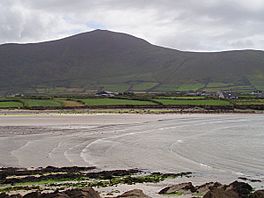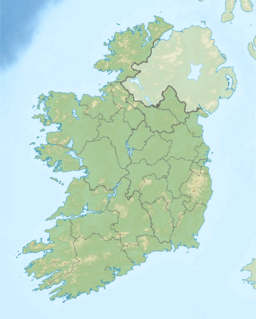Ferriter's Cove facts for kids
Ferriter's Cove (Irish: Cuan an Chaoil) is a small, beautiful bay located on the very western edge of the Dingle Peninsula in County Kerry, Ireland. It's a special place known for its amazing history and stunning natural beauty. The local Irish name for the cove is Cuan an Chaoil.
Quick facts for kids Ferriter's Cove |
|
|---|---|

Ferriter's Cove
|
|
| Location | County Kerry, Munster, Ireland |
| Coordinates | 52°10′16″N 10°26′49″W / 52.171°N 10.447°W |
| Type | Cove |
| Part of | Atlantic Ocean |
What's in a Name?
The English name for Ferriter's Cove comes from the Ferriter family. Their family name comes from the old Norman French words le Fereter.
The first known person with this name in the area was Walter le Fereter. He likely arrived with other Normans from Dublin. Records from 1252 mention him twice.
The Ferriter family also owned the nearby area of Dunurlin. You can still find their name in the village of Baile 'n Fheirtéaraigh (Ballyferriter) nearby.
Exploring the Geography
The rocks around Ferriter's Cove tell an ancient story. At the northern end, you'll find rocks from the Devonian period. This was about 419 to 359 million years ago.
These rocks include sandstone and siltstone. Further south, you can see older rocks from the Silurian period. These are about 444 to 419 million years old. They include volcanic rocks like lavas.
The weather in this area is mild. In January, the average temperature is about 8°C (46°F). In July, it's around 16°C (61°F).
Rainfall is higher in winter, with about 207mm (8 inches) in January. In summer, it's less, around 153mm (6 inches) in July. Winds are strongest in winter, especially in November. They are much calmer in summer.
Discovering Ancient History
Ferriter's Cove is a very important place for understanding Ireland's past. Digs done in the late 1900s found proof that people lived there during the Mesolithic period. This was the Middle Stone Age.
The excavations at Ferriter's Cove were led by Peter C. Woodman. These digs started after an amateur archaeologist found a flint knife in 1983. At first, they thought it was from the Neolithic period.
Woodman's team found tools that showed the site was used in the late Mesolithic. They found a grindstone and marked sandstone pebbles. There were also piles of shells and several old fireplaces.
Five mudstone axes were found placed together. Scientists believe people stayed here for short times over a thousand years. There were at least three main periods of use.
No formal burials were found at Ferriter's Cove. However, some pieces of human bone and teeth were discovered. One bone was dated to between 4225 and 3950 BC. Another was from 4250 to 3980 BC.
In 2012, new research confirmed that early farmers lived at Ferriter's Cove. This was the first proof of farming in Ireland! Scientists studied the remains of cattle and sheep.
Sheep were not native to Ireland, so they must have been brought by people. Carbon dating showed these animals were alive around 4350 BC. This means farming started very early in Ireland.



